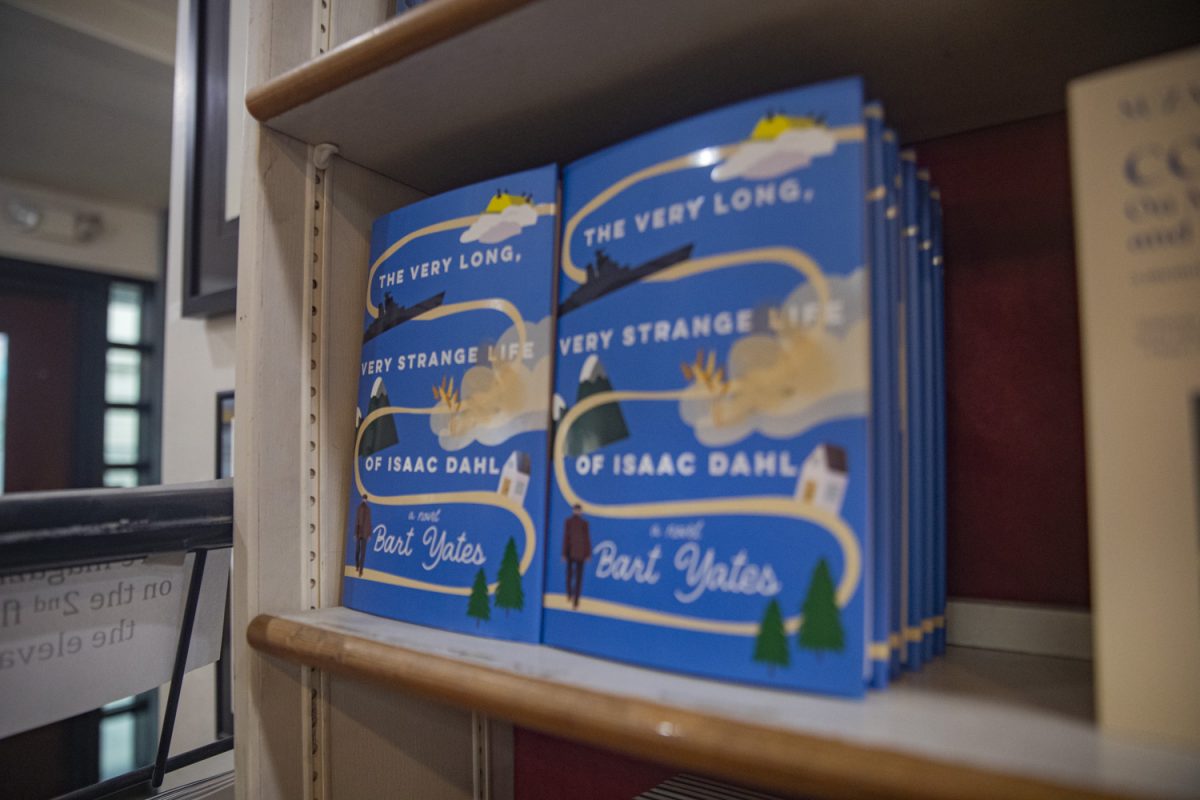
Walking into Ethan Diehl’s studio apartment felt a bit like walking onto a movie set of how an artist’s home should appear, so perfectly artsy, it was very nearly cliché.
The door opened into a long hallway lined with his oil paintings, predominantly black and white but with a few splashes of color throughout, all brightly lit.
As we continued down the passage, the apartment widened into a spacious glass room overlooking downtown Iowa City — a beautiful seventh-story view of the Ped Mall, the Arcade Building, the green-glass skywalk bridging the two biology buildings, and the towering steeples of several local landmarks. More art lines the walls here, too, but works of friends and fellow artists, not his own.
A partially completed colorless image of a woman sat on a modern-looking wooden easel, locked into place. But it hadn’t always been so secure; pointing to a smear of black and white turning into gray, Diehl said with a chuckle that was where the painting had fallen onto his head a few days previously, wiping paint across his hairless head and spreading it into squares of his painting.
Yes, squares of the painting. An oil painter, Diehl paints faces, primarily women’s faces, based on photos he has taken of them. Using Adobe Photoshop, he breaks the photographs down into grids, usually 1/6-by-1/6 inch squares on a canvas as large as 5-by-5 feet, and painstakingly paints each section individually with a Silver Bristlon Flat Zero brush — the only brush he uses.
“It’s kind of simple what I’m trying to accomplish,” Diehl said. “I come from a long line of storytellers; we tell stories, and I tell stories through my art. I use women’s faces and figures as a vehicle to tell a story about me or my family or my life.”
And it’s been an interesting life.
Born in Austin, Texas, Diehl moved to Iowa when his father, Paul Diehl, was offered a position at Grinnell College. A few years later, Paul Diehl became head of the University of Iowa’s Nonfiction Writing Program and the family moved again.
Growing up a block south of the Field House, Diehl used to sell chocolate-chip cookies in front of his home on Hawkeye football game days as he colored outside.
“There was always art around our house,” Diehl said. “From the earliest times, I can remember crayons and pencils and pens.”
The crayons, in particular, stick out to Diehl. One day, his older sister peeled off all the labels on his crayons, and Diehl, who said he always wanted to color everything the correct shade and stay inside the lines, could not tell which colors to use. His perfect blue sky came out purple.
That day Diehl discovered he was colorblind.
But that didn’t dampen his love for art. His experience with art at West High, though, did. His first high-school class, an art class, ended with him handcuffed to a desk, a “joke” by a senior, and his art classes did not much improve from there.
So he went off to college but not as an art major.
“I went to Stanford to be a rocket scientist. Literally,” Diehl said. “I wanted to build space weaponry. I didn’t want to kill people; I just wanted to blow shit up in space.”
As fun as that sounded at the time, he soon grew unhappy and bored, missing art. So he enrolled in a few art classes and, at the start of his junior year, became an art major.
And he was a terrible painter.
But he got better, working for hours a day, improving, honing his skill.
Then he graduated and stopped making art for four years.
When his now ex-wife, also an artist, got a job in California, Diehl went with her and decided to get back to art. He applied to five graduate-school art programs and got five rejections on his 25th birthday. Then he got divorced. And then, he began painting again.
He painted continually, 40 or 50 hours a week, and he got picked up by a few galleries, one in Austin and one in San Francisco.
Then, while watching “60 Minutes,” he saw a piece on Chuck Close, an artist known for his huge paintings of faces that up close seem abstract but at a distant show a distinct image of a face.
That led to his current painting style.
After finding a subject, Diehl takes a still image, almost always in his own apartment. Despite the close range, he uses a telephoto lens, allowing him to get a clear, close up photo from the other side of the room.
“I wanted to take the photos of people as far away as I could,” Diehl said. “I stand at one end of the room with my telephoto lens, and they’d be at the other, and it was like I was a wildlife photographer. I’d get much more natural photographs that way.”
Those natural photographs, once broken down into a grid, become his oil paintings, done in black and white to preserve their integrity and prevent color mistakes.
Though the paintings are time consuming, taking months to paint each tiny 1/6-by-1/6 inch square, it’s a labor of love for Diehl.
“Painting is addictive for me,” he said. “I may stop making good paintings, but I’ll never stop painting.”






